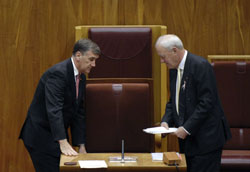15 Relief of President
-
The Deputy President shall take the chair whenever requested so to do by the President during a sitting of the Senate, without any formal communication to the Senate.
-
During the absence of the Deputy President, the President may call upon any one of the Temporary Chairmen of Committees to relieve temporarily in the chair, without any formal communication to the Senate.
Amendment history
Adopted: 19 August 1903 as SO 31
Amended:
- 5 October 1922, J.107 (provision for appointment of temporary chairman removed to a separate standing order)
- 2 December 1965 , J.427 (to take effect 1 January 1966)(paragraph (2) added)
- 22 October 1981, J.589 (change of title of office)
1989 revision: Old SOs 31 and 31 A combined intoone, structured as two paragraphs and renumbered as SO 15; minor rephrasing of paragraph (2) and removal of gender specific pronoun
Commentary

The President is relieved in the Chair by the Deputy President or a temporary chair of committees. Here, the Deputy President, Senator the Hon. Alan Ferguson is about to take the chair from the President, Senator the Hon. John Hogg (Photo courtesy of AUSPIC)
As proposed by the Standing Orders Committee, the precursor to SO 15 was copied from SO 4a of the Victorian Legislative Assembly.[1] Adopted as SO 31, it originally included authorisation for the President to appoint a panel of temporary chairmen of committees, a provision later made into a separate standing order following a tidying up exercise in 1922 (see SO 12 above).
What is now paragraph (2) was adopted as SO 31 A on the recommendation of the Standing Orders Committee in 1965.[2] The report remarked that the adoption of the standing order would “obviate the necessity of moving, at the commencement of each Session, a motion in terms similar to the proposed Standing Order”.
Standing Order 15 does not authorise the President to relinquish the chair to the Deputy President in order to speak from the floor. If the President is in the chamber, he or she must take the chair unless the Senate is in committee of the whole.